It looks like you're using an Ad Blocker.
Please white-list or disable AboveTopSecret.com in your ad-blocking tool.
Thank you.
Some features of ATS will be disabled while you continue to use an ad-blocker.
Last Minute DIY Alternate Hurricane Anchors (mobile homes etc) AND My Advanced Hurricane Ice Guide
page: 126
share:
If you find yourself trying to anchor your building down at the last moment, and anchors are all sold out, well I've got something even better (that
may be CHEAPER).
AND
Forget about wasting money on bags of ice, which will be sold out, I've got something better (that's FREE).
So I'm in a all steel mobile building, double wide. Similar in concept nut not quite a mobile home. I couldn't afford the hurricane anchors by the time I got this property ready and got it here. Went last year got edges and hits by multiple tropical storms even a piece of some hurricane. Had wind gusts get up to around 50MPH or so but not felt the thing wiggle. Whatever. But then here's comes Hurricane Irma, the 'most powerful storm in the history of the known universe', and those last couple days they had the final track the thin black line version went straight over top of my roof for all intensive purposes...
DIY ANCHORS
I went to get anchors during the week before Irma but nope already sold out. Expected that, and I already couldn't afford the storm as it was. So it was time to invent something. I grabbed the damaged bags of cement stuffs for the 50% discount, and back home to dig around the shop.
Amongst my metal, of use, I had one and a half beams of "Unistrut" and 1/4" conduit pipe. Unistrut is the metal beam material used in commercial construction. It lays across the proper trusswork, bolts down, and then electricians and 'tin knockers' anchor / strap their electrical / duct work to it. It has nice big holes all down the sides almost perfect to slide a section of conduit pipe into...
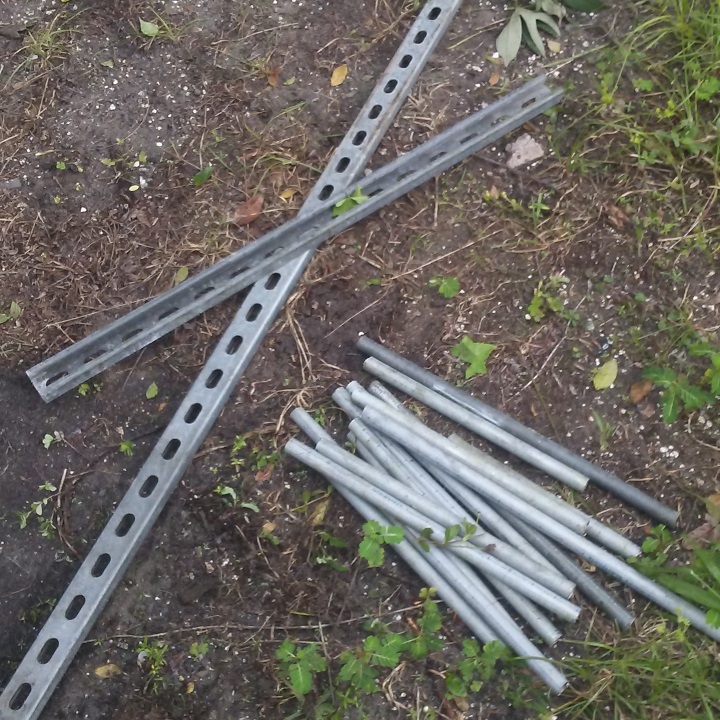
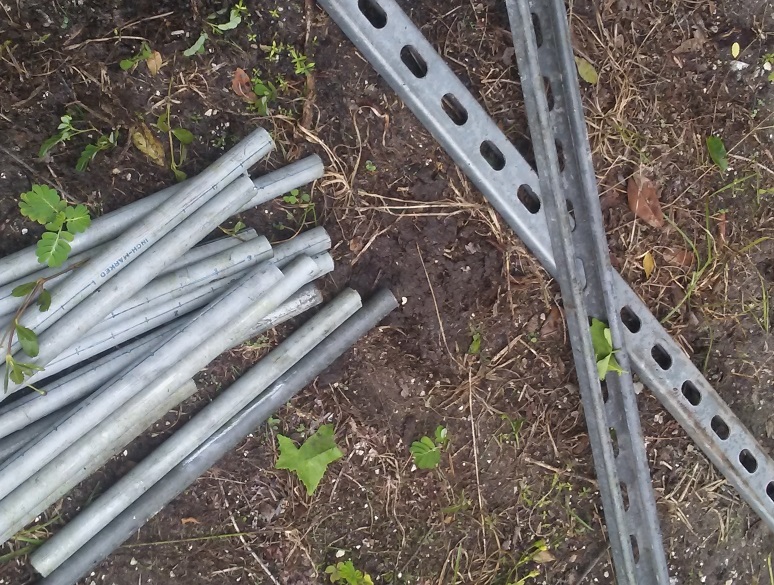
As you can see the holes are more oval shape, but a little hammer action to slightly flatten them out and viola:
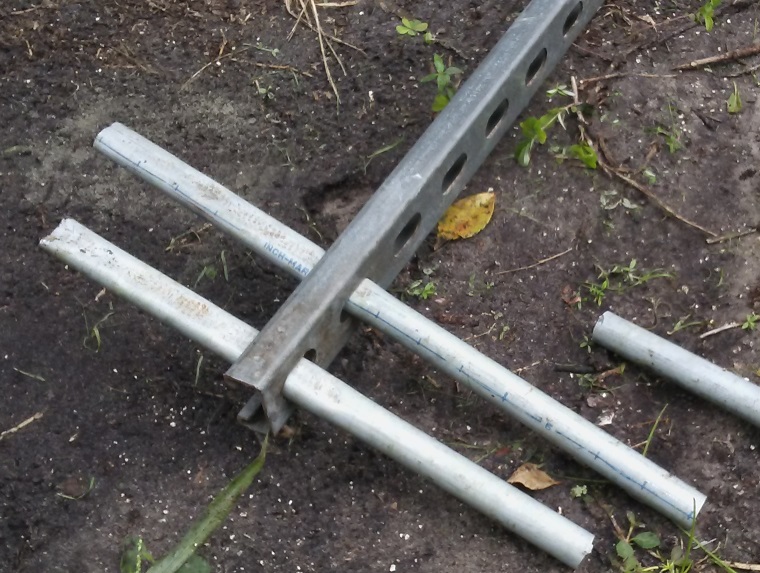
Now you want to cut the conduit longer than the space, and to insert you slant them all down the one direction and then tap them level as you reach the unistrut into the bottom of the hole (which is caverned out down in the bottom). I ended up having 3-4 conduit cross pieces per anchor (the more you can mange the better).
I had several bags of semi-hard cement on hand so I smashed all that up and rammed the chunks down in there while pouring the wet cement, all methodical like.
You just need a sawzall to cut both materials, and get about 3 'anchors' per 10' stick of Unistrut. Unistrut is about $20 per stick, proper anchors are about $20 each.
Now I only had enough for 4 anchors, when normally with the base area of this building it'd have maybe 20 anchors or a little less.

But I wasn't too freaked out because normally anchors are either drilled in via their auger heads and thats it. Since most of the ground down here is sand, and auger bits having or 4" or 5" or whatever auger bit tip, I figure my anchors cemented in real nice would have to be worth every bit of 3 normal anchors.
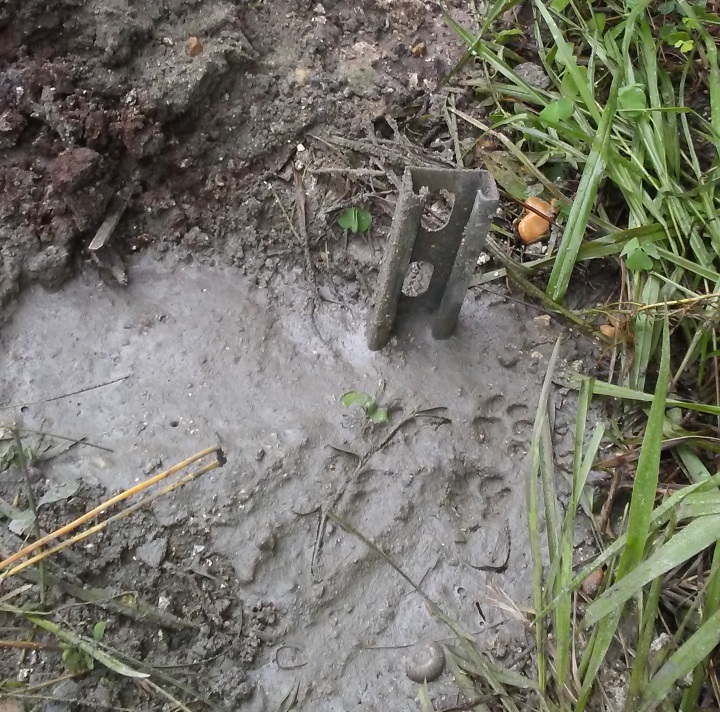
The trick is how to attach the building to the mere four anchors in a way that would match the strength of '20' straps hooked down. Normally the straps are some nice sturdy sheet metal strapping, but I happened to have some 300' of 3/8" aluminium rope on hand, so got the proper clamps and snaked the rope all into the steel truss etc under-carriage through the anchors and clamped them tight.
The hook up part was a blast as I was trying to save that for last amongst preparing a mountain of equipment etc on this property for a direct hit in a big block barn building sure to blow away... so was going to do it at like 4AM before I went to bed, to then be able to evacuate to the big city first thing in the morning. Prolbem is when I was working in the dark in the barn I got stung by something BAD on my finger, where normally bees / wasps stings barely even bother me after and here my whole hand was swelling up and all my body joints started aching within 20 minutes tot eh tune I was pretty sure it must have been a black widow. So at 2AM my whole performance schedule was wrecked.
So when I got up I had like an hour left to finish a bunch of other BS inside and out, aluminum rope the building to the anchors, herd the cats and pack the truck and not forget to do anything. all while the hurricane was already blowing and hard spritzing.
I came to find out that since the rope was in 3 100' strands, used, all coiled as one, to separate them and then wrestle the over-lengthed ropes to each side under there, in the dark on a bunch of beers and 72 hours intense prepping, yeah that wasn't going to work well alone in the dark.
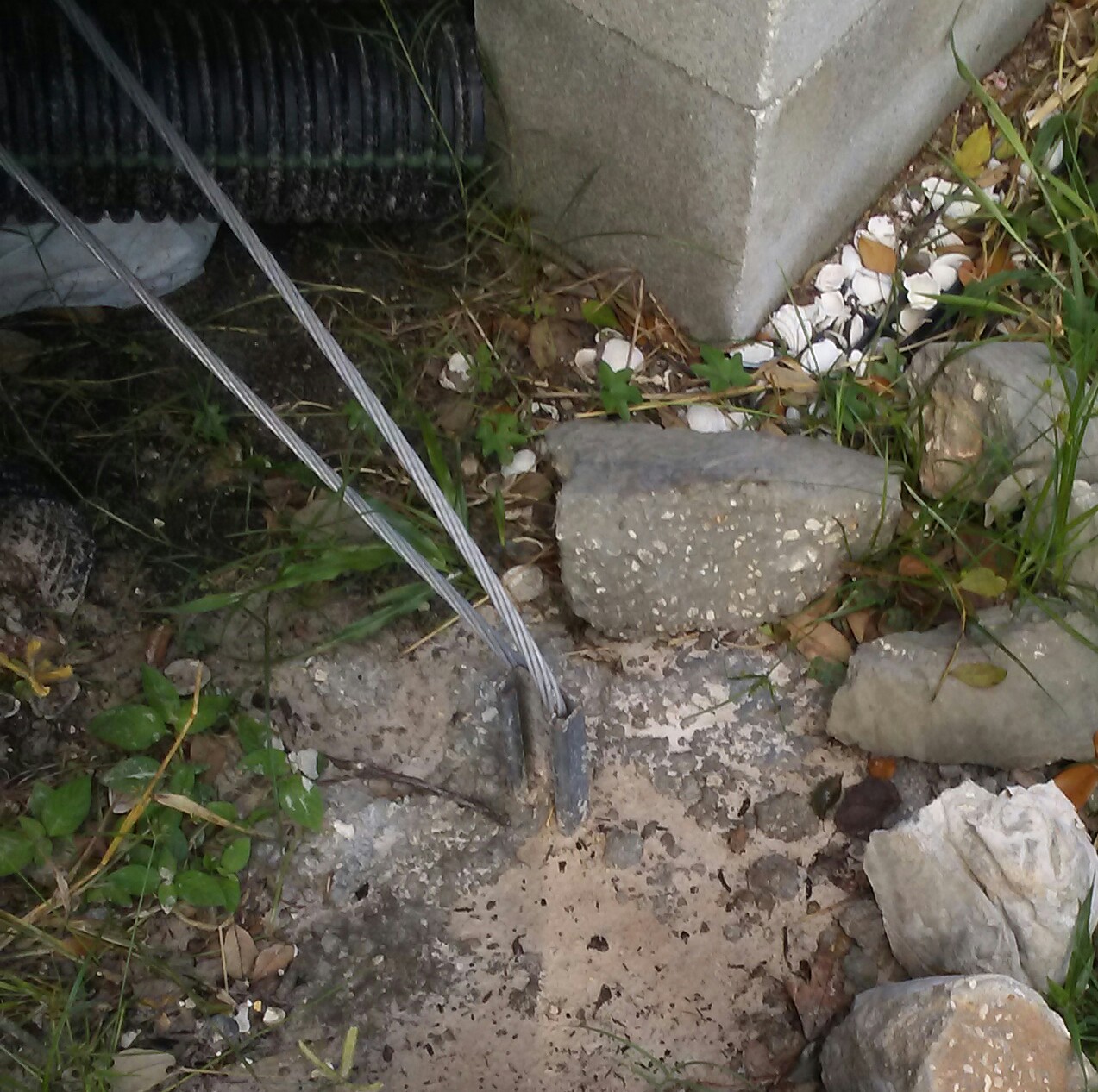
Here you can see a standard sheet metal strap dangling (I wanted to hook those too where possible but was out of time):
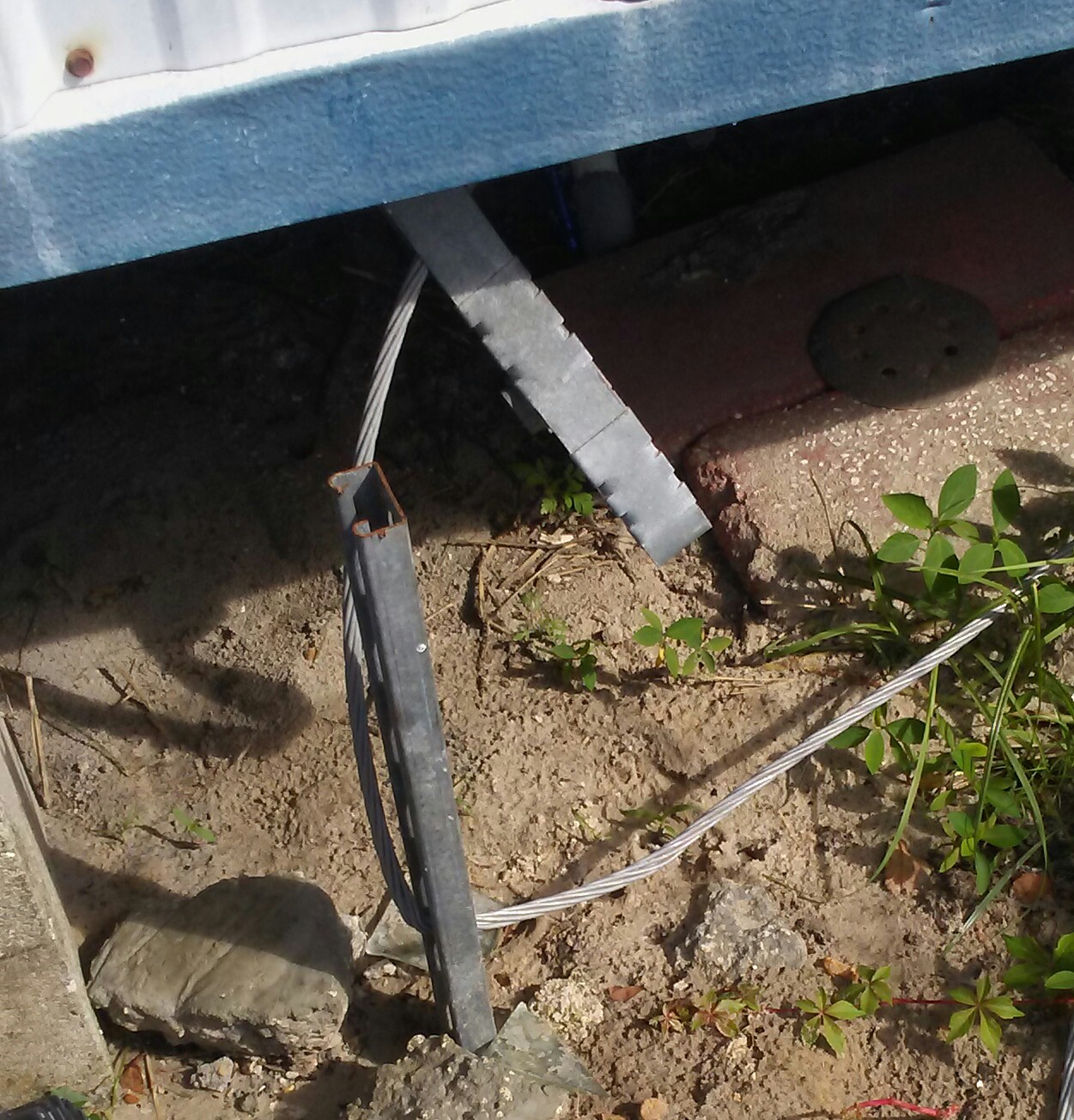
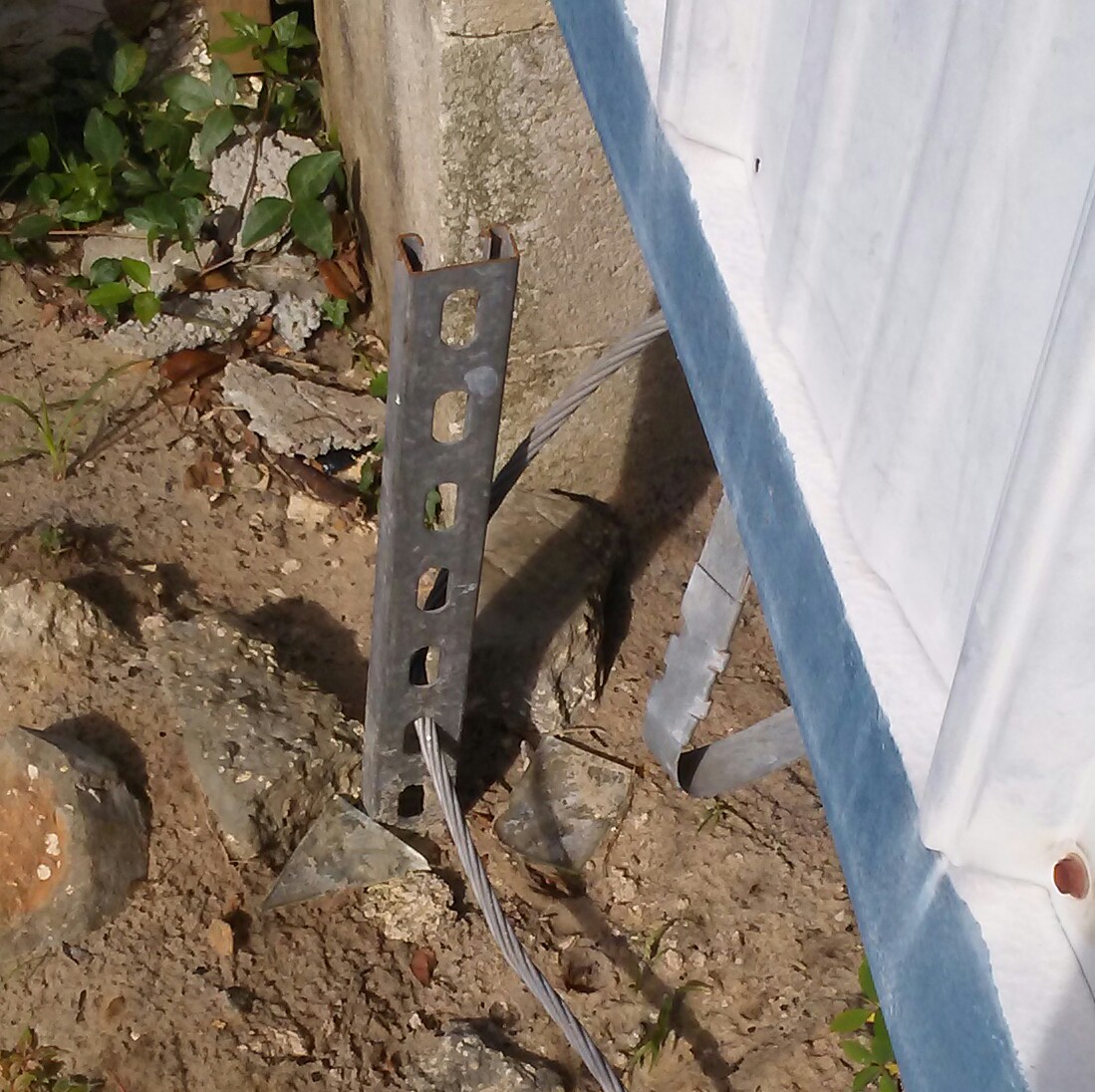
But I managed, got out in time for if it did hit, which it 'didn't', and I wasn't going to lose a finger whatever bit / stung me. And as I could tell we did have here winds go well beyond the 50MPH+ I seen last year, its wasnt too bad and the building was perfect.
Yeah I wanted to get this method posted earlier but the hassle caused by the 72 hour 'Hurricane Me' on the place, and the storm itself, in conjunction with this damn phone almost never shows up when I plug it into the computer here, this is as soon as I had the photos and everything ready.
DIY ICE
Note in the past I'd just make 'bars' / blocks. This year I realized I could fill gallon ziplock bags, double bag and then freeze them. This worked out well as they're kind of flat. I made about 8 of them and had everything else froze solid so when I pulled out of here I had 3 coolers of almost solid ice.
However, if you have the materials on hand and the space, my friend e took it up a notch and froze gallon jugs solid.
But the following insights work perfectly good too.
As posted elsewhere in the forum earlier this year:
Dont buy bags of ice. They melt in a day.
Get out all your plastic tupperware containers and make bars / blocks of ice. Start about 4-5 days out and keep rocking em. Just dont fill the containers over half full or the water swells up and breaks the tubs.
A coolers stuft with blocks/bars last up to a week.
In planning a big move its occurred to me to set about freezing everything I possibly can in the couple days before I break down the fridge. I have a ton of jars and bottles of fancy sauces and such for example. Basically freeze everything solid and cycle them back into the fridge (turned to max cold) while wrapping up as many item that last 48 hours. Creamy stuff frozen solid should hold its core temp longer than frozen water would. The more solid the item the better if you've ever tried to thaw a thick meat inside the fridge then you'll know it doesnt go so quickly. So make nice solid ice cubes out of your mustard, meat, etc. Everything but your produce really (fresh produce typically needs to be 'blanched' before freezing).
AND
Forget about wasting money on bags of ice, which will be sold out, I've got something better (that's FREE).
So I'm in a all steel mobile building, double wide. Similar in concept nut not quite a mobile home. I couldn't afford the hurricane anchors by the time I got this property ready and got it here. Went last year got edges and hits by multiple tropical storms even a piece of some hurricane. Had wind gusts get up to around 50MPH or so but not felt the thing wiggle. Whatever. But then here's comes Hurricane Irma, the 'most powerful storm in the history of the known universe', and those last couple days they had the final track the thin black line version went straight over top of my roof for all intensive purposes...
DIY ANCHORS
I went to get anchors during the week before Irma but nope already sold out. Expected that, and I already couldn't afford the storm as it was. So it was time to invent something. I grabbed the damaged bags of cement stuffs for the 50% discount, and back home to dig around the shop.
Amongst my metal, of use, I had one and a half beams of "Unistrut" and 1/4" conduit pipe. Unistrut is the metal beam material used in commercial construction. It lays across the proper trusswork, bolts down, and then electricians and 'tin knockers' anchor / strap their electrical / duct work to it. It has nice big holes all down the sides almost perfect to slide a section of conduit pipe into...


As you can see the holes are more oval shape, but a little hammer action to slightly flatten them out and viola:

Now you want to cut the conduit longer than the space, and to insert you slant them all down the one direction and then tap them level as you reach the unistrut into the bottom of the hole (which is caverned out down in the bottom). I ended up having 3-4 conduit cross pieces per anchor (the more you can mange the better).
I had several bags of semi-hard cement on hand so I smashed all that up and rammed the chunks down in there while pouring the wet cement, all methodical like.
You just need a sawzall to cut both materials, and get about 3 'anchors' per 10' stick of Unistrut. Unistrut is about $20 per stick, proper anchors are about $20 each.
Now I only had enough for 4 anchors, when normally with the base area of this building it'd have maybe 20 anchors or a little less.

But I wasn't too freaked out because normally anchors are either drilled in via their auger heads and thats it. Since most of the ground down here is sand, and auger bits having or 4" or 5" or whatever auger bit tip, I figure my anchors cemented in real nice would have to be worth every bit of 3 normal anchors.

The trick is how to attach the building to the mere four anchors in a way that would match the strength of '20' straps hooked down. Normally the straps are some nice sturdy sheet metal strapping, but I happened to have some 300' of 3/8" aluminium rope on hand, so got the proper clamps and snaked the rope all into the steel truss etc under-carriage through the anchors and clamped them tight.
The hook up part was a blast as I was trying to save that for last amongst preparing a mountain of equipment etc on this property for a direct hit in a big block barn building sure to blow away... so was going to do it at like 4AM before I went to bed, to then be able to evacuate to the big city first thing in the morning. Prolbem is when I was working in the dark in the barn I got stung by something BAD on my finger, where normally bees / wasps stings barely even bother me after and here my whole hand was swelling up and all my body joints started aching within 20 minutes tot eh tune I was pretty sure it must have been a black widow. So at 2AM my whole performance schedule was wrecked.
So when I got up I had like an hour left to finish a bunch of other BS inside and out, aluminum rope the building to the anchors, herd the cats and pack the truck and not forget to do anything. all while the hurricane was already blowing and hard spritzing.
I came to find out that since the rope was in 3 100' strands, used, all coiled as one, to separate them and then wrestle the over-lengthed ropes to each side under there, in the dark on a bunch of beers and 72 hours intense prepping, yeah that wasn't going to work well alone in the dark.

Here you can see a standard sheet metal strap dangling (I wanted to hook those too where possible but was out of time):


But I managed, got out in time for if it did hit, which it 'didn't', and I wasn't going to lose a finger whatever bit / stung me. And as I could tell we did have here winds go well beyond the 50MPH+ I seen last year, its wasnt too bad and the building was perfect.
Yeah I wanted to get this method posted earlier but the hassle caused by the 72 hour 'Hurricane Me' on the place, and the storm itself, in conjunction with this damn phone almost never shows up when I plug it into the computer here, this is as soon as I had the photos and everything ready.
DIY ICE
Note in the past I'd just make 'bars' / blocks. This year I realized I could fill gallon ziplock bags, double bag and then freeze them. This worked out well as they're kind of flat. I made about 8 of them and had everything else froze solid so when I pulled out of here I had 3 coolers of almost solid ice.
However, if you have the materials on hand and the space, my friend e took it up a notch and froze gallon jugs solid.
But the following insights work perfectly good too.
As posted elsewhere in the forum earlier this year:
Dont buy bags of ice. They melt in a day.
Get out all your plastic tupperware containers and make bars / blocks of ice. Start about 4-5 days out and keep rocking em. Just dont fill the containers over half full or the water swells up and breaks the tubs.
A coolers stuft with blocks/bars last up to a week.
In planning a big move its occurred to me to set about freezing everything I possibly can in the couple days before I break down the fridge. I have a ton of jars and bottles of fancy sauces and such for example. Basically freeze everything solid and cycle them back into the fridge (turned to max cold) while wrapping up as many item that last 48 hours. Creamy stuff frozen solid should hold its core temp longer than frozen water would. The more solid the item the better if you've ever tried to thaw a thick meat inside the fridge then you'll know it doesnt go so quickly. So make nice solid ice cubes out of your mustard, meat, etc. Everything but your produce really (fresh produce typically needs to be 'blanched' before freezing).
While rubbermaid type plastics crack if over half full with water while freezing, pretty much everything you buy that goes into the fridge should
freeze solid fine without that issue.
So freeze your milk, and everything else that last couple days.
And make some bars of ice (see page 1) too if there's time.
And some cubes for making drinks.
Power goes off immediately open the fridge doors and start transferring everything into coolers (now afforded with not having to do it in intense haste.
And make sure you leave those fridge doors open the whole times it off.
Eat the ice cream asap, and then get drunk till the power comes back on...
There's lots of little things...
With meats, worse comes to worse and too much meat and too long of no power expected, cook all the meats on the grill and then pack back into coolers. Well, if you cant refrigerate, they might sit better at room temp NOT in dark in plastic bags (where mold becomes the menace).
Cooked meat has an entirely different bio profile than raw meat. Consider beef jerky for example. Raw meat goes bad in half a day a day in room temp. Cooked meats can go much much longer. Raw meat turns rancid. Cooked meat hardly does that. Other decomposition forces tend to do the job with cooked meat, and over longer periods. And don't forget, as long as meat isn't rancid just reheat it again. You're body wont let you it it for most of the worries. The thing with bacteria is, unless the meat came pre-loaded with disease germs then they aren't just going to appear because you left it out (especially not after a full cook). If you can eat cold pre-cooked meat from the fridge without hardly ever getting food poisoning your whole life then yeah. Truth is most the meat 'left out to long' metrics are for restaurants where lawsuits are on the line, where the cooking staff is doing everything assembly line style and need to maintain strict easy to follow standards. You at home with your personalized touch, you'll know whats whats, what each specimen has been thru since you got it home and you're not going to sue yourself so don't freak out too much about some of those semi-paranoid USDA numbers. Just recook it real well if you're not sure. You eat something on the order of pounds of bacteria every however many months. And for all you germaphobes: your very own body had some 15 pounds of bacteria living inside it, and you'd DIE without them.
Fish is an exception. Seafood really ins a whole nother animal in this. I'd tell you to follow the USDA guidelines, although I doubt your body would allow you to eat anything gone wrong.
If you keep a big jug of lemon juice (best purchased at little ethnic grocery stores) then you can store the fish at room temp in the lemon/lime juice, and it will actually "cook". AKA "Ceviche".
Water the other big one. It gets bad enough there's always water in the toilet tank, the hot water heat tank, the pipes under the house.
I've gone literally months remote with no water power etc. The thing I never read about in survival pages on the water topic is the water you 'need' (that you aren't going to drink).
Fill you tubs to the brim to run the toilets, and for wash.
Just scooping water out of a bucket you can actually get just about a full bathing off a gallon or two.
I'd prefer to have a bunch of rubbing alcohol on hand for the feet.
And those aloe 'adult baby wipes' for the rear.
Your rear and your feet are what get nasty. Keep those clean, if not breaking much of a sweat all day and not getting 'actually' 'dirty' you can go longer than you might expect without a shower and not even be nasty / smelly. Although getting sweaty necessitates a bathing more than just getting 'dirty', as your arms get all dirty you can just rinse them off real quick. Sweat is what makes your body sticky, and after you get that sticky feeling it makes you feel hotter than clean dry skin.
But make sure you have all your undies and socks clean in advance. You need to change those.
If you'll be sweating all day you'll want some medicated body powder from the dollar store.
And if you wear double layers of socks your feet wont get all nasty sticking to the bottoms of your shoes even on LONG hot labor intense days in dirty old work shoes.
COOLER TIPS
-Ice melts into... water! Everything is in there with it: You'll be compelled to drain the water, but to get maximum ice durability you must leave the water in there. You'll be compelled to pour the ice in from the bag it comes in, but you must leave it in the bag for maximum ice durability. This will help with the water issue, maybe. But count on water. Therefore have a big box of ziplock bags, and bag all that stuff up. If water could readily penetrate the an item once in the bag, then you need to double bag it (this include shredded cheese that's already in its own bag: it will fill with water if in only one added bag). If you're using your own ice and have some suitable bags bag it up. Keeping the air off the high surface volume ice is the key, whether it be in a bag, or in water (ideally both, in cells). One gallon tupperware tub can be nice to put stuff into of course, and it should float when the ice melts. But space is an issue to you'll just have to figure it out with what you've got, of course.
-Set one cooler up for stuff that you wouldnt get around to needing to get into the next 'up to a week'. Then have the other for the stuff you'll want the first few days of no power. The long haul cooler tape the seam, wrap it in space blankets, then pile blankets and stuff on top of it. And DO NOT OPEN IT unless you get some ice to dump in later. You can also throw extra insulative layers over the quick shot cooler as well.
FIN
So freeze your milk, and everything else that last couple days.
And make some bars of ice (see page 1) too if there's time.
And some cubes for making drinks.
Power goes off immediately open the fridge doors and start transferring everything into coolers (now afforded with not having to do it in intense haste.
And make sure you leave those fridge doors open the whole times it off.
Eat the ice cream asap, and then get drunk till the power comes back on...
There's lots of little things...
With meats, worse comes to worse and too much meat and too long of no power expected, cook all the meats on the grill and then pack back into coolers. Well, if you cant refrigerate, they might sit better at room temp NOT in dark in plastic bags (where mold becomes the menace).
Cooked meat has an entirely different bio profile than raw meat. Consider beef jerky for example. Raw meat goes bad in half a day a day in room temp. Cooked meats can go much much longer. Raw meat turns rancid. Cooked meat hardly does that. Other decomposition forces tend to do the job with cooked meat, and over longer periods. And don't forget, as long as meat isn't rancid just reheat it again. You're body wont let you it it for most of the worries. The thing with bacteria is, unless the meat came pre-loaded with disease germs then they aren't just going to appear because you left it out (especially not after a full cook). If you can eat cold pre-cooked meat from the fridge without hardly ever getting food poisoning your whole life then yeah. Truth is most the meat 'left out to long' metrics are for restaurants where lawsuits are on the line, where the cooking staff is doing everything assembly line style and need to maintain strict easy to follow standards. You at home with your personalized touch, you'll know whats whats, what each specimen has been thru since you got it home and you're not going to sue yourself so don't freak out too much about some of those semi-paranoid USDA numbers. Just recook it real well if you're not sure. You eat something on the order of pounds of bacteria every however many months. And for all you germaphobes: your very own body had some 15 pounds of bacteria living inside it, and you'd DIE without them.
Fish is an exception. Seafood really ins a whole nother animal in this. I'd tell you to follow the USDA guidelines, although I doubt your body would allow you to eat anything gone wrong.
If you keep a big jug of lemon juice (best purchased at little ethnic grocery stores) then you can store the fish at room temp in the lemon/lime juice, and it will actually "cook". AKA "Ceviche".
Water the other big one. It gets bad enough there's always water in the toilet tank, the hot water heat tank, the pipes under the house.
I've gone literally months remote with no water power etc. The thing I never read about in survival pages on the water topic is the water you 'need' (that you aren't going to drink).
Fill you tubs to the brim to run the toilets, and for wash.
Just scooping water out of a bucket you can actually get just about a full bathing off a gallon or two.
I'd prefer to have a bunch of rubbing alcohol on hand for the feet.
And those aloe 'adult baby wipes' for the rear.
Your rear and your feet are what get nasty. Keep those clean, if not breaking much of a sweat all day and not getting 'actually' 'dirty' you can go longer than you might expect without a shower and not even be nasty / smelly. Although getting sweaty necessitates a bathing more than just getting 'dirty', as your arms get all dirty you can just rinse them off real quick. Sweat is what makes your body sticky, and after you get that sticky feeling it makes you feel hotter than clean dry skin.
But make sure you have all your undies and socks clean in advance. You need to change those.
If you'll be sweating all day you'll want some medicated body powder from the dollar store.
And if you wear double layers of socks your feet wont get all nasty sticking to the bottoms of your shoes even on LONG hot labor intense days in dirty old work shoes.
COOLER TIPS
-Ice melts into... water! Everything is in there with it: You'll be compelled to drain the water, but to get maximum ice durability you must leave the water in there. You'll be compelled to pour the ice in from the bag it comes in, but you must leave it in the bag for maximum ice durability. This will help with the water issue, maybe. But count on water. Therefore have a big box of ziplock bags, and bag all that stuff up. If water could readily penetrate the an item once in the bag, then you need to double bag it (this include shredded cheese that's already in its own bag: it will fill with water if in only one added bag). If you're using your own ice and have some suitable bags bag it up. Keeping the air off the high surface volume ice is the key, whether it be in a bag, or in water (ideally both, in cells). One gallon tupperware tub can be nice to put stuff into of course, and it should float when the ice melts. But space is an issue to you'll just have to figure it out with what you've got, of course.
-Set one cooler up for stuff that you wouldnt get around to needing to get into the next 'up to a week'. Then have the other for the stuff you'll want the first few days of no power. The long haul cooler tape the seam, wrap it in space blankets, then pile blankets and stuff on top of it. And DO NOT OPEN IT unless you get some ice to dump in later. You can also throw extra insulative layers over the quick shot cooler as well.
FIN
edit on 7-10-2017 by IgnoranceIsntBlisss because: (no reason given)
I will stock up on alcohol and wipes. Also more ziplock bags. In Wisconsin we usually don't have this type of power outages but best to know some good
alternatives. Good advice on storing cold food. I am trying to can and dehydrate more types of food to lessen our dependence on the freezer.
I have thought that a smokehouse set up for the meat would be a good alternative to having to eat all the meat very quickly. Always thinking of a new project just need more time, money and energy.
I have thought that a smokehouse set up for the meat would be a good alternative to having to eat all the meat very quickly. Always thinking of a new project just need more time, money and energy.
I guess Nate is already making landfall. Hardly no threads were being posted about it I wasnt nudged to much acknowledge it, although this stupid
phone didnt show up on this new OS install the whole past week until this morning (to get the photos out) anyways.
a reply to: IgnoranceIsntBlisss
Lots of good information!
I was thinking that if you are not evacuating & you froze some gallon plastic jugs ahead, you could probably use the fridge as a cooler too.
It would take a lot more jugs that way though. Cover the fridge with heavy blankets or rugs, it should work for awhile. And as you use the food, you have the jugs thawing for drinking water.
My parents kept their first fridge when they got
a new one. Put it in the basement & used it as an extra freezer when they got a side of beef every fall. Cranked up the setting to the coldest & filled it with packs of already frozen meat. Kept everything frozen just like a regular freezer!
As they used the meat, they filled in the empty spots with frozen water jugs, to keep it at a constant temperature & save electric.
They were better insulated back then though!
Some tips we've picked up over the years:
Something we did with coolers when camping, was tried to keep one just for raw meats. Then there was no cross contamination of things that wouldn't need cooked. If we only took one cooler, we put the raw meat on the bottom of the cooler in a big plastic bag, so it didn't leak or drip on the other things.
Meat & fish can be sliced & sun dried into jerky. Fruit can be sun dried too. Apple & strawberry chips are good. Helps to have some way to keep the flies off. We save old sheer curtains to fasten around the drying food. Clothespins come in handy to fasten them shut & can be used for lots of other things.
You're right about cooked meat keeping longer than you would think. It's the way things were done before refrigeration. And my grandmother told me how her parents kept pork chops in a big crock in the basement. They poured pork grease over them in layers. She said sometimes they had to scrape mold off of the top ones. But nobody got sick. Probably because of the probiotics they got from the sauerkraut & pickles that they ate all the time!
My sister used to work in a grocery deli. The boss made them take the raw chicken from the grocery section, that was starting to go bad & wash it in water with some bleach in it to 'freshen' it up! Then cook it & sell it in the deli!!!
If you need to fill up containers with water, don't forget to fill up the wash machine too! Big, plastic, storage totes, even the drawers in the fridge will work if they aren't made in pieces!
You can put storage totes outside to catch rainwater too. Just make sure to put the lids on after to keep the mosquitoes out!
Make sure to unplug all your appliances & electronics when the power goes out, to protect against a possible power surge, when the power is restored. Get a bunch of solar yard lights at the dollar store. Put them in sunlight during the day & use them indoors around the house after dark. We do this when we go camping. Safe around little kids too. We put some around the perimeter of the area where the tents are, so we can see critters coming. And a line of them to the outhouse & some inside it too.
For women who miss washing their hair, baby corn starch sprinkled on your hair, rubbed in & brushed out will give you some extra days of not feeling 'uncivilized'! Regular cornstarch will work in a pinch too, but makes more static.
Sunlight kills germs & freshens things up too. No laundry soap? Baking soda works well & has many other uses. It's good to clean with. You can brush your teeth with it & use it to wash your face. Make a paste out of it to use as a deodorant. And environmentally friendly. We buy it in big boxes!
I wasn't familiar with cooking with citrus juice! Sounds good & it would be so easy to do!
One thing that I read once, was not to save refrigerator shelves to use to grill on over a fire.
It said most of them are made with cadmium!
If it's true, what the heck is it even doing in them???
Thanks for the all the helpful tips!
WOQ
Lots of good information!
I was thinking that if you are not evacuating & you froze some gallon plastic jugs ahead, you could probably use the fridge as a cooler too.
It would take a lot more jugs that way though. Cover the fridge with heavy blankets or rugs, it should work for awhile. And as you use the food, you have the jugs thawing for drinking water.
My parents kept their first fridge when they got
a new one. Put it in the basement & used it as an extra freezer when they got a side of beef every fall. Cranked up the setting to the coldest & filled it with packs of already frozen meat. Kept everything frozen just like a regular freezer!
As they used the meat, they filled in the empty spots with frozen water jugs, to keep it at a constant temperature & save electric.
They were better insulated back then though!
Some tips we've picked up over the years:
Something we did with coolers when camping, was tried to keep one just for raw meats. Then there was no cross contamination of things that wouldn't need cooked. If we only took one cooler, we put the raw meat on the bottom of the cooler in a big plastic bag, so it didn't leak or drip on the other things.
Meat & fish can be sliced & sun dried into jerky. Fruit can be sun dried too. Apple & strawberry chips are good. Helps to have some way to keep the flies off. We save old sheer curtains to fasten around the drying food. Clothespins come in handy to fasten them shut & can be used for lots of other things.
You're right about cooked meat keeping longer than you would think. It's the way things were done before refrigeration. And my grandmother told me how her parents kept pork chops in a big crock in the basement. They poured pork grease over them in layers. She said sometimes they had to scrape mold off of the top ones. But nobody got sick. Probably because of the probiotics they got from the sauerkraut & pickles that they ate all the time!
My sister used to work in a grocery deli. The boss made them take the raw chicken from the grocery section, that was starting to go bad & wash it in water with some bleach in it to 'freshen' it up! Then cook it & sell it in the deli!!!
If you need to fill up containers with water, don't forget to fill up the wash machine too! Big, plastic, storage totes, even the drawers in the fridge will work if they aren't made in pieces!
You can put storage totes outside to catch rainwater too. Just make sure to put the lids on after to keep the mosquitoes out!
Make sure to unplug all your appliances & electronics when the power goes out, to protect against a possible power surge, when the power is restored. Get a bunch of solar yard lights at the dollar store. Put them in sunlight during the day & use them indoors around the house after dark. We do this when we go camping. Safe around little kids too. We put some around the perimeter of the area where the tents are, so we can see critters coming. And a line of them to the outhouse & some inside it too.
For women who miss washing their hair, baby corn starch sprinkled on your hair, rubbed in & brushed out will give you some extra days of not feeling 'uncivilized'! Regular cornstarch will work in a pinch too, but makes more static.
Sunlight kills germs & freshens things up too. No laundry soap? Baking soda works well & has many other uses. It's good to clean with. You can brush your teeth with it & use it to wash your face. Make a paste out of it to use as a deodorant. And environmentally friendly. We buy it in big boxes!
I wasn't familiar with cooking with citrus juice! Sounds good & it would be so easy to do!
One thing that I read once, was not to save refrigerator shelves to use to grill on over a fire.
It said most of them are made with cadmium!
If it's true, what the heck is it even doing in them???
Thanks for the all the helpful tips!
WOQ
a reply to: wasobservingquietly
As soon as the power goes off, pretty much, the fridge should be opened and not closed again until the power back on and its cleaned out. You're toying with molds growing deep inside there all sorts of grimy details along those lines.
As soon as the power goes off, pretty much, the fridge should be opened and not closed again until the power back on and its cleaned out. You're toying with molds growing deep inside there all sorts of grimy details along those lines.
I like that rig.
I have an old house of single wall construction (you may have to look that one up) and a large shed roof (aka, a sail). But I think that if I could tie the eaves down it would help.
I have an old house of single wall construction (you may have to look that one up) and a large shed roof (aka, a sail). But I think that if I could tie the eaves down it would help.
a reply to: Phage
Lots of island houses are built with single wall and corrugated roofs, and finding a good way to anchor them could make all the difference in a storm.
Some good tips in the OP, especially with ice maintenance. I do a lot of camping, and being able to keep things cold and safe for several days is very important. Especially useful for disaster preparedness as well.
Lots of island houses are built with single wall and corrugated roofs, and finding a good way to anchor them could make all the difference in a storm.
Some good tips in the OP, especially with ice maintenance. I do a lot of camping, and being able to keep things cold and safe for several days is very important. Especially useful for disaster preparedness as well.
a reply to: VariableConstant
1-1/4" vertical grain redwood. I would hate to see it blow away.
They don't make wood like that anymore.
1-1/4" vertical grain redwood. I would hate to see it blow away.
They don't make wood like that anymore.
edit on 10/8/2017 by Phage because: (no reason given)
My personal favorite I learned taking food to festivals or out camping. Pack your food in layers by day...fill with ice and water, but save a bit of
room at the end. Last toss in a pound or 2 of dry ice and vola...it will freeze solid and solid ice as you've said lasts forever.
a reply to: IgnoranceIsntBlisss
Good thread and excellent advice. From what I see on TV, people in the US are allowed to use seatainers for homes. It would seem to me that using them to make a home and by welding them all together and by making achors as you describe, one would have a good strong home that would beat any cyclone.
Good thread and excellent advice. From what I see on TV, people in the US are allowed to use seatainers for homes. It would seem to me that using them to make a home and by welding them all together and by making achors as you describe, one would have a good strong home that would beat any cyclone.
originally posted by: Phage
a reply to: VariableConstant
1-1/4" vertical grain redwood. I would hate to see it blow away.
They don't make wood like that anymore.
Buy wood glue by the gallon and soak it into every crack / joint / seam. And when each spot soaks it in and the crack again reveals 'caulk' it with the wood glue again. And again.
very nice little setup. only thing id be worried about is over time aluminum can fatigue and become brittle and break so down the road when its
feasible id probly change that out with steel cable. shouldnt be a problem for years though and maybe never if it doesnt get torqued on too often. btw
its always nice to have a little camp stove around with a couple tanks of propane so in an emergency you always have a way to boil some water or cook
some food.
edit on 8-10-2017 by TheScale because: (no reason given)
new topics
-
Trump's truth and reconciliation commission
Politicians & People: 24 minutes ago -
Liberal women going on sex strike over Trump win
US Political Madness: 35 minutes ago -
Where ARE the 20 million votes??? Where ARE they????? WHERE???
US Political Madness: 2 hours ago -
President-Elect DONALD TRUMP's 2nd-Term Administration Takes Shape.
Political Ideology: 3 hours ago -
The Democratic Party’s Stay Behind Program
US Political Madness: 4 hours ago -
Celestial Objects in Far Northern Reaches of Alaska (Polar Mystery)
Fragile Earth: 5 hours ago -
82 yr Woman Arrested for Hate Crime after Assaulting Trump Supporters
2024 Elections: 6 hours ago -
Groaners II
Jokes, Puns, & Pranks: 8 hours ago -
Lunacy
Short Stories: 8 hours ago -
Political Labels Quizzes
Political Ideology: 9 hours ago
top topics
-
All Talk No Walk Celebrities Blowing Smoke
US Political Madness: 12 hours ago, 16 flags -
Where ARE the 20 million votes??? Where ARE they????? WHERE???
US Political Madness: 2 hours ago, 15 flags -
Interesting timing 40 monkeys flee medical lab in US
Diseases and Pandemics: 10 hours ago, 15 flags -
Arizona and Nevada Called for Trump – Giving Trump 312 Electoral Votes
2024 Elections: 13 hours ago, 14 flags -
What shenanigans are at play with the house races?
2024 Elections: 16 hours ago, 12 flags -
Why Dems Are Probably Wishing Trump Won in 2020...
US Political Madness: 9 hours ago, 10 flags -
The Democratic Party’s Stay Behind Program
US Political Madness: 4 hours ago, 10 flags -
President-Elect DONALD TRUMP's 2nd-Term Administration Takes Shape.
Political Ideology: 3 hours ago, 9 flags -
A question about abortion and the states
US Political Madness: 16 hours ago, 8 flags -
82 yr Woman Arrested for Hate Crime after Assaulting Trump Supporters
2024 Elections: 6 hours ago, 8 flags
active topics
-
Liberal women going on sex strike over Trump win
US Political Madness • 8 • : rickymouse -
TODAY IS A HUGE ELECTION DAY FOR AMERICA - November 5th 2024 - Reports from Around The Nation.
2024 Elections • 740 • : WeMustCare -
Where ARE the 20 million votes??? Where ARE they????? WHERE???
US Political Madness • 18 • : berbofthegreen -
Post A Funny (T&C Friendly) Pic Part IV: The LOL awakens!
General Chit Chat • 7751 • : underpass61 -
On Nov. 5th 2024 - AMERICANS Prevented the Complete Destruction of America from Within.
2024 Elections • 114 • : WeMustCare -
About that ''Iron Dome''
Other Current Events • 34 • : BingoMcGoof -
Trump's truth and reconciliation commission
Politicians & People • 0 • : Daughter2v2 -
President-Elect DONALD TRUMP's 2nd-Term Administration Takes Shape.
Political Ideology • 17 • : VariedcodeSole -
-@TH3WH17ERABB17- -Q- ---TIME TO SHOW THE WORLD--- -Part- --44--
Dissecting Disinformation • 3178 • : WeMustCare -
82 yr Woman Arrested for Hate Crime after Assaulting Trump Supporters
2024 Elections • 16 • : Irishhaf
26
